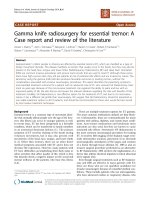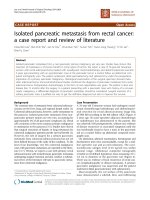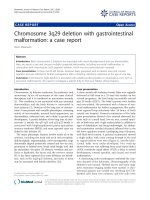Báo cáo y học: "Primary glioblastoma in the pineal region: a case report and review of the literature" potx
Bạn đang xem bản rút gọn của tài liệu. Xem và tải ngay bản đầy đủ của tài liệu tại đây (2.93 MB, 5 trang )
BioMed Central
Page 1 of 5
(page number not for citation purposes)
Journal of Medical Case Reports
Open Access
Case report
Primary glioblastoma in the pineal region: a case report and review
of the literature
Kyung-Sub Moon
1
, Shin Jung*
1
, Tae-Young Jung
1
, In-Young Kim
1
, Min-
Cheol Lee
2
and Kyung-Hwa Lee
3
Address:
1
Department of Neurosurgery, Chonnam National University Research Institute of Medical Sciences, Chonnam National University
Hwasun Hospital & Medical School, Gwangju, Republic of Korea,
2
Department of Pathology, Chonnam National University Medical School,
Gwangju, Republic of Korea and
3
Department of Pathology, Seonam University, College of Medicine, Namwon, Republic of Korea
Email: Kyung-Sub Moon - ; Shin Jung* - ; Tae-Young Jung - ; In-
Young Kim - ; Min-Cheol Lee - ; Kyung-Hwa Lee -
* Corresponding author
Abstract
Introduction: Glioblastoma in the pineal region is extremely rare with only a few cases reported
in the literature.
Case presentation: A 68-year-old man presented with a sudden deterioration manifesting as a
headache, vomiting and gait disturbance. A magnetic resonance imaging study revealed a
heterogeneously ring-enhanced mass in the pineal region. The mass was subtotally removed
through the occipital transtentorial approach, and diagnosed as a glioblastoma.
Conclusion: We discuss the clinical course, radiological findings and treatment strategies of pineal
glioblastoma with a review of the relevant literature.
Introduction
The pineal region consists of the pineal body, the poste-
rior wall of the third ventricle, tela choroidea and velum
interpositum. Despite its small size, a wide variety of brain
tumors can arise in the pineal region. Tumors of the pin-
eal body may be of pineal parenchymal origin, of extrago-
nadal germ cell origin, or of neuroglial origin [1].
Approximately 11–28% and 50–75% of tumors in the
pineal region are pineal parenchymal tumors and germ
cell tumors, respectively [1]. In addition, glioma, menin-
gioma and mesenchymal tumors are encountered occa-
sionally. Glioblastoma, which is the most malignant and
frequent glioma in brain tumors, is extremely rare in the
pineal region with only 17 cases being reported in the lit-
erature [2-13]. This paper presents a case of glioblastoma
arising in the pineal region and discusses its clinical
course, radiological findings and treatment strategies with
a review of the relevant literature.
Case presentation
A 68-year-old man presented with a sudden deterioration
manifesting as a headache, vomiting and gait disturbance.
Two months earlier, he had begun to notice intermittent
headaches. Neurological testing revealed ataxic gait fea-
tures and bilateral papilledema without other neurologi-
cal deficits. The computed tomography (CT) scan revealed
obstructive hydrocephalus caused by a round hypodense
ill-defined lesion in the pineal region (Fig. 1A). A mag-
netic resonance (MR) imaging study demonstrated a 4 × 3
× 4 cm mass at the pineal gland. Through the administra-
tion of gadolinium, the lesion showed a heterogeneous
hypointensity on the T
1
-weighted image and hyperinten-
Published: 27 August 2008
Journal of Medical Case Reports 2008, 2:288 doi:10.1186/1752-1947-2-288
Received: 15 January 2008
Accepted: 27 August 2008
This article is available from: />© 2008 Moon et al; licensee BioMed Central Ltd.
This is an Open Access article distributed under the terms of the Creative Commons Attribution License ( />),
which permits unrestricted use, distribution, and reproduction in any medium, provided the original work is properly cited.
Journal of Medical Case Reports 2008, 2:288 />Page 2 of 5
(page number not for citation purposes)
sity on the T
2
image as well as ring-enhancement with an
extension into the midbrain and thalamus (Fig. 1B and
1C). No hematological or biochemical abnormalities
were evident, and the other tumor markers, such as α-feto-
protein, β-human chorionic gonadotrophin and placental
alkaline phosphatase were within normal limits. Surgery
was performed using the occipital transtentorial approach
because a non-germinomatous malignant tumor was con-
sidered a possibility. During the operation, a very soft,
gray-colored mass was located in the pineal region, which
was barely demarcated from the peritumoral brain. Some
hard portions were found in the tumor. An examination
of frozen biopsy samples showed anaplastic astrocytic
tumor cells. The mass was subtotally removed due to
adhesion with the hypothalamus and midbrain, and its
severe bleeding nature. The pathologic findings revealed a
typical glioblastoma consisting of frequent mitotic fig-
ures, a high proliferation index, microvascular prolifera-
tion with endothelial cell hyperplasia, and extensive
necrosis with focal pseudopalisading (Fig. 2A). Immuno-
histochemistry revealed a positive reaction to the glial
fibrillary acidic protein in both cell bodies and processes
(Fig. 2B). A further review of the pre-operative MR imag-
ing study showed an enhanced mass in the fourth ventri-
cle that was consistent with ependymal dissemination
(Fig. 1D). Two weeks after surgery, the patient underwent
a ventriculoperitoneal shunt due to the rapid exacerbation
of signs and symptoms of the hydrocephalus. Considering
the pathological and radiological findings, whole neu-
raxis irradiation therapy was recommended. However, his
Non-contrast computed tomography scan showing a hypointense mass in the pineal region (A)Figure 1
Non-contrast computed tomography scan showing a hypointense mass in the pineal region (A). T
1
-weighted sag-
ittal (B) and gadolinium-diethylenetriaminepentaacetic acid enhanced axial (C and D) magnetic resonance images demonstrat-
ing a heterogeneously ring-enhanced mass with central necrosis in the pineal region and ependymal dissemination in the fourth
ventricle.
AB
CD
Journal of Medical Case Reports 2008, 2:288 />Page 3 of 5
(page number not for citation purposes)
family insisted on conservative medical support. The
patient died 2 months after the diagnosis.
Discussion
Pineal gliomas include fibrillary astrocytoma, pilocytic
astrocytoma, anaplastic astrocytoma, glioblastoma, oli-
godendroglioma, ependymoma and choroid plexus pap-
illoma [1]. Among these entities, well differentiated
astrocytomas are the most common [1]. Since the report
of Bradfield and Perez in 1972 [3], only 18 cases including
this one have described a glioblastoma of the pineal
region (Table 1) [2,4-13]. The patients reported with a
pineal glioblastoma consisted of nine women and six
men aged from 5 to 68 years (mean, 39.3 years). Com-
pared with those of germ cell or parenchymal tumors in
the pineal gland, pineal glioblastomas occur in middle
aged adults with a slight female preponderance.
All reported cases of pineal glioblastomas have presented
with signs or symptoms of increased intracranial pressure
and hydrocephalus. Eight patients (57.1%) with a pineal
glioblastoma also presented with visual or gaze distur-
bances, including diplopia, blurry vision, nystagmus and
upgaze palsy, which were mainly consistent with Parin-
aud's syndrome. However, the clinical symptoms and
signs of pineal glioblastomas are similar to other tumors
in the pineal region, which makes them difficult to diag-
nose based on the clinical history and presentation alone.
MR imaging of pineal glioblastomas demonstrate charac-
teristic features. Heterogeneous enhancement with a cen-
trally located non-enhanced portion indicates central
necrosis. Infiltration into the surrounding structures, such
as midbrain and thalamus, is shown as hyperintensity on
the T
2
-weighted MR image, extending beyond the margin
of the enhanced mass. Despite its rapid and infiltrative
nature, glioblastomas generally do not invade the sub-
arachnoid space, and rarely metastasize through the cere-
brospinal fluid pathway [14]. However, a review of pineal
glioblastoma revealed leptomeningeal or ventricular dis-
semination to be quite common (7 in 10 available cases).
Among these cases, two cases, including the present one,
showed pre-operative dissemination on the initial radio-
logical study. Upon a careful review of pre-operative MR
imaging for a pineal region mass, an enhancing nodule in
the subarachnoid space or ventricle system can assist in
the diagnosis of glioblastoma.
Considering that most patients with pineal glioblastoma
multiforme (GBM) show symptoms and signs of hydro-
cephalus, an endoscopic third ventriculostomy and tissue
biopsy may be an appropriate treatment for pineal gliob-
lastoma. However, according to Amini et al. [2], this pro-
cedure was unable to resolve the hydrocephalus over time
and obtain sufficient tissue samples in two out of three
cases. The benefit of an aggressive surgical resection in the
treatment of pineal GBM is unclear. Two patients who
underwent a surgical resection only, including ours, died
2 months after the diagnosis [8]. The average survival in
the three cases who received radiation therapy alone was
3.3 months (range, 2 to 4 months) [2,7,10]. However,
adjuvant radiation therapy and/or chemotherapy after a
surgical resection may prolong the survival of patients
with a pineal glioblastoma. The three patients who under-
went a surgical resection and radiation therapy lived an
average of 5.3 months (range, 4 to 6 months) [4,9,13].
Furthermore, the mean survival duration of the four
(A) Photomicrograph showing numerous anaplastic astro-cytic tumor cells with mitosis, large multinucleated giant cells with abundant eosinophilic cytoplasm, and an extensive area of necrosisFigure 2
(A) Photomicrograph showing numerous anaplastic
astrocytic tumor cells with mitosis, large multinucle-
ated giant cells with abundant eosinophilic cyto-
plasm, and an extensive area of necrosis. (B)
Photomicrograph of the immunohistochemical study showing
a positive reaction for the glial fibrillary acidic protein (GFAP)
(A: hematoxylin and eosin stain, original magnification, ×100,
B: original magnification, ×200).
A
B
Journal of Medical Case Reports 2008, 2:288 />Page 4 of 5
(page number not for citation purposes)
Table 1: Summary of reported cases of pineal glioblastoma multiforme
Author/Year Age/Sex Symptoms Radiological findings Leptomeningeal
dissemination
Treatment Survival
Bradfield et al./1972 53/F N-A Obstructive HDC, mass in
post. 3rd ventricle
No on autopsy Resection Postoperative death
Bradfield et al./1972 5/F N-A Obstructive HDC, mass in
post. 3rd ventricle
No on autopsy Shunt 27 mos
DeGirolami et al./1973 3 cases Intracranial hypertension,
vertical gaze palsy in one
case
N-A N-A RT for all cases, Resection
for only one case
N-A
Kalyanaraman/1979 68/F Ataxia, confusion, urinary
incontinence, upgaze
limitation
CT: HDC, calcified midline
mass
N-A Resection, RT 4 mos
Norbut et al./1981 36/M HA, blurry vision, Parinaud's
syndrome
CT: HDC, mass in post. 3rd
ventricle
Yes on autopsy (4th
ventricle, leptomeninges of
cerebral cortex,
interpeduncular fossa, brain
stem, and spinal cord)
Shunt, RT 4 mos
Frank et al./1985 52/F Intracranial hypertension,
oculomotor disturbances
HDC, mass in 3rd ventricle N-A Stereotactic biopsy, RT 4 mos
Edwards et al./1988 12/F N-A N-A N-A Resection, RT,
Chemotherapy
18 mos
Vaquero et al./1990 63/M HA, changing of behavior CT: rounded hyperdense
mass with ring enhancement
N-A Shunt, Resection, Whole
brain RT
6 mos
Pople et al./1993 6/F HA, N/V, diplopia, decreased
visual acuity, 6th cranial
nerve palsy, upgaze limitation
CT & MR: HDC, enhancing
mass
Yes on FU CT (frontal &
occipital lobes, scattered
leptomenges)
Shunt, Resection, local RT,
Chemotherapy
4 mos
Cho et al./1998 10–15/F N-A N-A N-A Resection, RT 6 mos
Gasparetto et al./2003 29/F HA, drowsiness, fever,
dizziness, seizure,
CT & MR: ill-defined
heterogeneously enhanced
mass with extension to
thalamus
No Shunt, Resection 2 mos
Toyooka et al./2005 49/M HA, diplopia, memory
disturbance
MR: irregular
heterogeneously enhanced
mass
Yes on FU MR (lateral
ventricle, pons,
pontomedullary junction)
Shunt, Resection,
Chemotheraphy (ACNU),
local RT
11 mos
Amini et al./2006 40/M HA, N/V, diplopia, blurry
vision
CT: Obstructive HDC,
strong enhancement,
punctuate calcification
MR: heterogenously
enhancing with central
necrosis, extension into
midbrain
Yes on initial MR
(cbll, medulla, temporal lobe)
Endoscopic TVB, Resection,
Shunt, Whole brain RT,
Chemotherapy (Temodar)
5 mos
Amini et al./2006 43/M HA, disequilibrium,
decreased level of mental
status
MR: heterogenously
enhancing, HDC
Yes on FU MR
(intraventricular)
TVB, Resection, Whole
brain RT, Chemotherapy
7 mos
Amini et al./2006 52/F HA, N/V, diplopia, blurry
vision, upgaze palsy
MR: heterogenously
enhancing with central
necrosis, obstructive HDC
Yes on FU MR (lateral
ventricle, leptomeninges of
brain & spine)
Endoscopic TVB, RT 2 mos
Present case/2006 68/M HA, N/V, Ataxia CT: HDC, hypodense mass
MR: irregular
heterogeneously ring-
enhanced mass with central
necrosis
Yes on initial MR (4th
ventricle)
Resection, Shunt 2 mos
F, female; FU, follow-up; M, male; mos, months; MR, magnetic resonance; CT, computed tomography; HA, headache; N/V, nausea & vomiting; HDC, hydrocephalus; RT, radiation therapy; N-A,
not available; post., posterior; TVB, third ventriculostomy & biosy
Publish with BioMed Central and every
scientist can read your work free of charge
"BioMed Central will be the most significant development for
disseminating the results of biomedical research in our lifetime."
Sir Paul Nurse, Cancer Research UK
Your research papers will be:
available free of charge to the entire biomedical community
peer reviewed and published immediately upon acceptance
cited in PubMed and archived on PubMed Central
yours — you keep the copyright
Submit your manuscript here:
/>BioMedcentral
Journal of Medical Case Reports 2008, 2:288 />Page 5 of 5
(page number not for citation purposes)
patients who received radiation therapy and chemother-
apy after the surgical resection was 7 months (range, 4 to
11 months) [2,11,12].
The overall prognosis of a patient with a pineal glioblast-
oma is poor. Despite every effort in treatment, the maxi-
mum survival duration is less than 1 year after diagnosis
(except for a single case reported by Bradfield and Perez
[3]).
Conclusion
Glioblastoma in the pineal region is a very rare disease.
However, in middle aged patients, a heterogeneously ring-
enhanced mass in the pineal region with leptomeningeal
dissemination on MR imaging can raise the suspicion of
glioblastoma. Even though it is impossible to conclude
the best treatment modality, early adjuvant radiation ther-
apy and chemotherapy after surgical resection appear to
prolong the survival of patients with a pineal glioblast-
oma.
Competing interests
The authors declare that they have no competing interests.
Authors' contributions
KSM carried out the review of the literature and write up
of the manuscript. SJ performed the surgery and was the
coordinator of the study. JTY summarized the patient
notes and carried out the literature search. KIY partici-
pated in the draft of the study, and in the conception of
the study. MCL participated in the histopathological anal-
ysis, and in the coordination of the study. KHL partici-
pated in the draft of the study, and contributed to the
work on the histopathology of the case including immu-
nohistochemical work-up. All authors read and approved
the final manuscript.
Consent
Written informed consent was obtained from the patient's
relative for publication of this case report and any accom-
panying images. A copy of the written consent is available
for review by the Editor-in-Chief of this journal.
References
1. Hirato J, Nakazato Y: Pathology of pineal region tumors. J
Neuro-Oncol 2001, 54:239-249.
2. Amini A, Schmidt RH, Salzman KL, Chin SS, Couldwell WT: Gliob-
lastoma multiforme of the pineal region. J Neuro-Oncol 2006,
79:307-314.
3. Bradfield JS, Perez CA: Pineal tumors and ectopic pinealomas.
Analysis of treatment and failures. Radiology 1972, 103:399-406.
4. Cho BK, Wang KC, Nam DH, Kim DG, Jung HW, Kim HJ, Han DH,
Choi KS: Pineal tumors: experience with 48 cases over 10
years. Childs Nerv Syst 1998, 14:53-58.
5. DeGirolami U, Schmidek H: Clinicopathological study of 53
tumors of the pineal region. J Neurosurg 1973, 39:455-462.
6. Edwards MS, Hudgins RJ, Wilson CB, Levin VA, Wara WM: Pineal
region tumors in children. J Neurosurg 1988, 68:689-697.
7. Frank F, Gaist G, Piazza G, Ricci RF, Sturiale C, Galassi E: Stereo-
taxic biopsy and radioactive implantation for interstitial
therapy of tumors of the pineal region. Surg Neurol 1985,
23:275-280.
8. Gasparetto EL, Warszawiak D, Adam GP, Bleggi-Torres LF, de Car-
valho Neto A: Glioblastoma multiforme of the pineal region:
case report. Arq Neuropsiquiatr 2003, 61:468-472.
9. Kalyanaraman UP: Primary glioblastoma of the pineal gland.
Arch Neurol 1979, 36:717-718.
10. Norbut AM, Mendelow H: Primary glioblastoma multiforme of
the pineal region with leptomeningeal metastases: a case
report. Cancer 1981, 47:592-596.
11. Pople IK, Arango JC, Scaravilli F: Intrinsic malignant glioma of the
pineal gland. Childs Nerv Syst 1993, 9:422-424.
12. Toyooka T, Miyazawa T, Fukui S, Otani N, Nawashiro H, Shima K:
Central neurogenic hyperventilation in a conscious man with
CSF dissemination from a pineal glioblastoma. J Clin Neurosci
2005, 12:834-837.
13. Vaquero J, Ramiro J, Martinez R: Glioblastoma multiforme of the
pineal region. J Neurosurg Sci 1990, 34:149-150.
14. Kleihues P, Burger PC, Aldape KD, Brat DJ, Biernat W, Bigner DD:
Glioblastoma. In WHO Classification of Tumours of the Central Nerv-
ous Systems 4th edition. Edited by: Louis DN, Ohgaki H, Wiestler OD,
Cavenee WK. Lyon: IARC; 2007:33-49. [Bosman FT, Jaffe ES, Lakhani
SR, Ohgaki H (Series Editors).]









